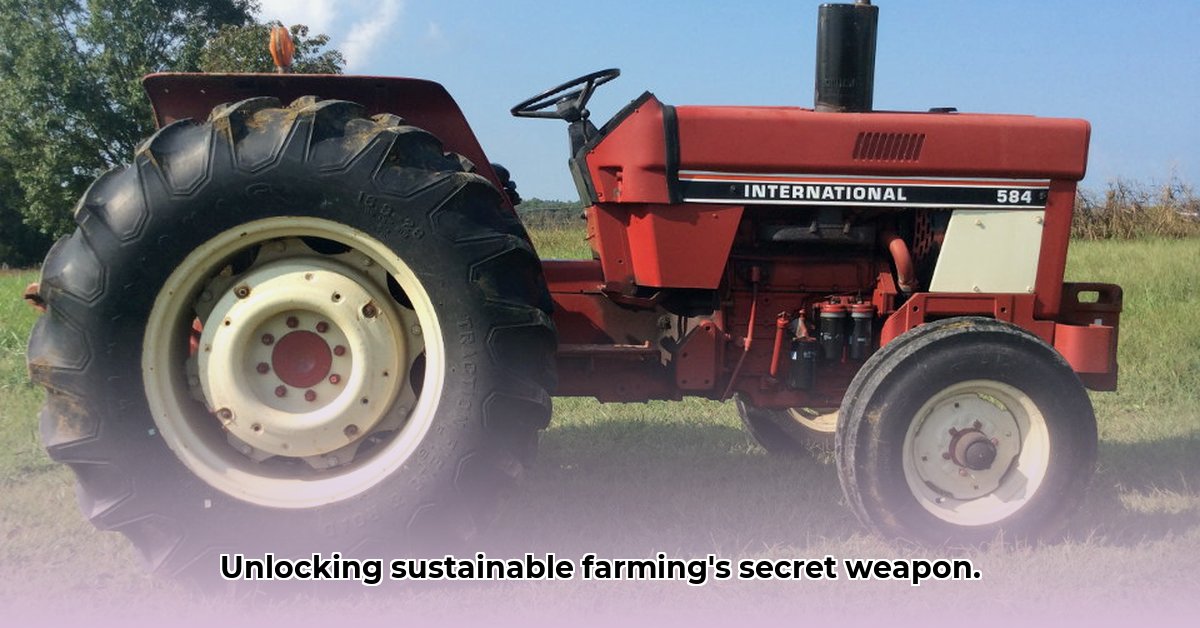
The International Harvester 584: A Case Study in Sustainable Agriculture
The International Harvester (IH) 584 tractor, produced from 1977 to 1984, presents a compelling case study in the intersection of vintage machinery and modern sustainable farming practices. Its enduring reputation for durability and longevity raises questions about its overall environmental impact compared to more modern, fuel-efficient counterparts. This analysis explores the advantages and disadvantages of using the IH 584 in sustainable agriculture, highlighting data limitations and offering actionable intelligence for diverse stakeholders. For more information on the IH 584, see this helpful resource.
Durability: A Legacy of Longevity
The IH 584’s robust construction is undeniable. Many examples remain operational, showcasing exceptional durability. This longevity directly contributes to sustainable agriculture by reducing the need for frequent tractor replacements, thereby minimizing manufacturing waste and resource consumption. However, this durability is intertwined with potential drawbacks regarding maintenance and parts availability, as discussed below.
Power and Fuel Efficiency: A Data Gap
The IH 584's 60-horsepower engine, while modest by today's standards, was well-suited for its time. Some agricultural experts suggest its lower power output may have resulted in lower fuel consumption per acre compared to larger, more powerful tractors performing similar tasks. However, precise data on fuel efficiency for the IH 584 is scarce. This lack of quantitative data significantly hampers a comprehensive assessment of its environmental impact within a modern sustainable farming context.
Maintenance and Parts: The Cost of Longevity
Maintaining an IH 584 requires more attention than newer tractors. Sourcing parts can be challenging, and repairs may be costly. These factors are critical to evaluating its long-term sustainability. While the initial purchase price may be low, the potentially higher long-term maintenance costs must be carefully considered against the environmental benefits of extended tractor lifespan.
Sustainable Farming Implications: Simplicity and Scale
The IH 584’s relative simplicity, lacking advanced features like GPS guidance or automated steering, can be advantageous for smaller farms or those prioritizing low-impact farming methods. Its manageable size and lower power requirements align with the principles of reduced resource consumption and minimized environmental disruption. However, a conclusive assessment of its suitability for sustainable farming hinges upon addressing the aforementioned data gap concerning precise fuel consumption.
Actionable Intelligence: Guiding Steps for Stakeholders
The following actions will improve understanding and utilization of the IH 584 across different sectors:
| Stakeholder | Short-Term Actions | Long-Term Strategies |
|---|---|---|
| Small-Scale Farmers | Pre-purchase inspection; budget for potential repairs; explore alternative fuels. | Preventative maintenance; fuel efficiency optimization strategies; lifecycle cost analysis. |
| Agricultural Historians/Museums | Preserve operational manuals and maintenance records; document its historical use. | Secure and maintain examples for future generations; research historical impact on agriculture. |
| Parts Suppliers/Repair Shops | Stock common replacement parts; train mechanics in repair techniques. | Invest in remanufacturing; partner with recycling facilities; explore 3D-printing of parts. |
| Researchers | Conduct a comprehensive lifecycle assessment (LCA); gather precise fuel consumption data. | Develop energy-efficient designs inspired by the 584’s robust structure; analyze economic viability. |
The Need for Further Research: Closing the Data Gap
To definitively assess the IH 584's role in modern sustainable agriculture, further research is critical. This includes a comprehensive lifecycle assessment (LCA) with detailed fuel consumption data across various operating conditions. Such data would enable a robust comparison to modern tractors, providing a clear picture of the IH 584’s environmental impact. Economic studies comparing the lifecycle costs of the IH 584 against newer models, considering maintenance expenses, are also needed. The current information provides a preliminary assessment, but insufficient data limits definitive conclusions.
Estimating IH 584 Fuel Efficiency: A Practical Methodology
Determining the precise fuel efficiency of a vintage tractor like the IH 584 requires a manual approach. This methodology offers a practical way to estimate fuel consumption:
- Precise Fuel Measurement: Completely fill the tank; record the initial level using a graduated measuring stick (gallons or liters).
- Operation Time Tracking: Use a stopwatch to record the precise duration of each work session, noting the type of work (plowing, tilling, etc.).
- Post-Operation Fuel Measurement: Refill the tank to full capacity; record the amount of fuel added.
- Fuel Consumption Calculation: Subtract the fuel added from the initial level to determine total fuel consumed.
- Fuel Consumption Per Hour: Divide total fuel consumed by the total operating time (in hours).
- Fuel Consumption Per Acre (Optional): If possible, measure the area worked. Divide total fuel consumed by the area (acres) to calculate consumption per acre.
Caveats: This method provides an approximation. Terrain, soil conditions, and workload significantly impact fuel consumption. Multiple work sessions under varying conditions are necessary for a more reliable estimate. The method's accuracy depends heavily on precise measurements.
Conclusion: The IH 584’s longevity and simple design offer potential benefits within sustainable agriculture. However, a thorough understanding of its fuel efficiency, maintenance costs, and overall lifecycle impact requires further research and data collection to fully evaluate its position within modern farming practices.